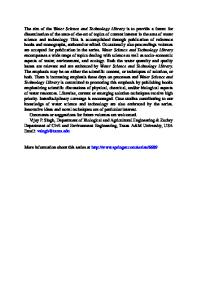Hydrological Processes of the Danube River Basin Perspectives from t
The Danube River Basin is shared by 19 countries and there is no river basin in the world shared by so many nations. Covering an area of about 800,000 km², it is Europe's second largest river basin and home to 83 million people of different cultures, lang
- PDF / 18,071,084 Bytes
- 441 Pages / 439.37 x 666.142 pts Page_size
- 102 Downloads / 398 Views
Mitja Brilly Editor
Hydrological Processes of the Danube River Basin Perspectives from the Danubian Countries
123
Editor Mitja Brilly University of Ljubljana Fac. Civil & Geodetic Engineering Jamova Cesta 2 SI-1000 Ljubljana Slovenia [email protected]
ISBN 978-90-481-3422-9 e-ISBN 978-90-481-3423-6 DOI 10.1007/978-90-481-3423-6 Springer Dordrecht Heidelberg London New York Library of Congress Control Number: 2010930853 © Springer Science+Business Media B.V. 2010 No part of this work may be reproduced, stored in a retrieval system, or transmitted in any form or by any means, electronic, mechanical, photocopying, microfilming, recording or otherwise, without written permission from the Publisher, with the exception of any material supplied specifically for the purpose of being entered and executed on a computer system, for exclusive use by the purchaser of the work. Cover images: photo of the Iron Gate provided by Dr. Ulrich Schroeder from the German IHP Committee; photo of the Danube near Belgrade, Serbia, provided by Mr. Borivoje Jovanovi´c. Printed on acid-free paper Springer is part of Springer Science+Business Media (www.springer.com)
Preface
The Danube River Basin is shared by 19 countries and there is no river basin in the world shared by so many nations. Europe’s second largest river basin with a total area of about 800,000 km2 is also home to 83 million people of different cultures, languages and historical backgrounds. Management of common water sources and overcoming difficulties caused by droughts and floods requires co-operation between the countries. In 1971 these common interests stimulated the hydrologists of – at that time – eight Danube countries to begin regional co- operation in the framework of the International Hydrological Decade of UNESCO. The result of this research was The Hydrological Monograph of the Danube and its Catchment, which was published in 1986. Since 1975 this co-operation has continued under the umbrella of the International Hydrological Programme (IHP) of UNESCO. In the past 20 years political turbulence has caused an increase in the number of countries, making the co-operation difficult at times. Nevertheless several projects were launched, and a number of reports were produced. At the 22nd Working Meeting of the Regional Hydrological Co-operation of the Danube Countries in the framework of IHP/UNESCO which took place at the XXIVth Conference of the Danubian Countries, in Bled, Slovenia, in 2008, it was decided that those reports would be summarised in one special publication that would include a few additional reports on the common research theme. The editorial board was also nominated. This present publication is the result of a major collaboration and our efforts to bring together the reports and research papers related to the regional co-operation.
v
Acknowledgements
The book is the result of a long co-operation in research, which included the efforts of many hydrologists and technical staff from different Universities and Agencies from all countries of th
Data Loading...











